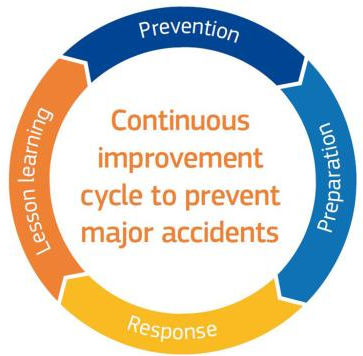Syllabus: GS3/Planning; Employment; Infrastructure
Context
- Recently, a major fire broke out after a reactor blast in Escientia Advanced Sciences Private Ltd. in the Special Economic Zone at Atchutapuram in Anakapalli of Andhra Pradesh leading to at least 17 workers being killed and 20 others sustained burns.
- The blast reportedly occurred after a reactor malfunctioned. The company manufactures intermediate chemicals and pharmaceutical ingredients.
Factory Accidents in India
- Industrial accidents pose significant risks to workers, communities, and the environment. In India, these incidents have been a cause for concern, affecting lives, livelihoods, and economic productivity.
- According to data by the National Disaster Management Authority (NDMA), 130 significant chemical accidents have been reported, which resulted in 259 deaths and left 563 people with major injuries in the past ten years.
Common Causes of Factory/Industrial Accidents
- Lack of Safety Measures: Some factories operate without proper safety protocols, including inadequate training, insufficient protective gear, and poorly maintained machinery.
- Fatal industrial accidents have been alarmingly frequent, with incidents reported in 2016, 2018, 2020, and 2023.
- Shockingly, the boiler in the chemical factory involved in the recent explosion was not even registered under the Indian Boiler Regulations, 1950.
- Human error like negligence and fatigue often lead to accidents.
- Unsafe Work Environments: Congested spaces, cluttered floors, and inadequate ventilation increase the risk of accidents. Additionally, factories dealing with hazardous materials (such as chemicals, gases, or heavy machinery) face heightened dangers.
- Machinery Malfunctions: Faulty equipment, lack of maintenance, and outdated machinery can lead to accidents. Workers operating heavy machinery are particularly vulnerable.
- Electrical Hazards: Electrical fires, shocks, and short circuits pose a significant risk in factories. Poorly insulated wiring and overloaded circuits contribute to accidents.
- Chemical Exposure: Factories dealing with chemicals (e.g., in the pharmaceutical, textile, or chemical industries) must handle them carefully. Accidental spills, leaks, or inhalation can have severe consequences.
- Low Inspection Rates: The inspection rates for hazardous factories are alarmingly low. For instance:
- In Maharashtra, only 23.89% of hazardous factories were inspected in 2021.
- Tamil Nadu had a general inspection rate of 17.04% and a hazardous factories inspection rate of 25.39%.
- Gujarat’s inspection rates were 19.33% (general) and 19.81% (hazardous).
- Nationally, the figures were 14.65% (general) and 26.02% (hazardous).
- Poor Prosecution Rates: The prosecution rates (decided cases as a percentage of total prosecutions) are also disheartening and far from satisfactory.
- Gujarat: 6.95%
- Maharashtra: 13.84%
- Tamil Nadu: 14.45%
Impact on Workers
- Injuries: Workers suffer cuts, burns, fractures, and other physical injuries due to machinery mishaps, falls, or chemical exposure.
- Amputations: As highlighted in a recent report, auto-sector workers often lose fingers due to crush injuries.
- Fatalities: Tragically, some accidents lead to loss of life.
- Long-Term Health Issues: Exposure to hazardous substances can cause chronic health problems, including respiratory issues, skin disorders, and cancers.
Steps Forward
- Awareness: Workers and employers must be educated about safety practices.
- Regular Inspections: Authorities should conduct routine inspections to identify safety gaps.
- Investment in Safety: Employers should prioritise safety measures, including proper training, safety gear, and well-maintained machinery.
- Legal Accountability: Strict enforcement of safety regulations is crucial.
Legal Framework
- India has laws and regulations aimed at ensuring workplace safety. The Occupational Safety, Health, and Working Conditions Code, 2020, consolidates provisions related to occupational safety and health.
- However, effective implementation and enforcement remain challenges,
- Government’s Initiatives like National Policy on Safety, Health and Environment at Workplace (NPSHEW), Industrial Safety and Disaster Management Plans, National Disaster Management Authority (NDMA), Bureau of Indian Standards (BIS), and Labour Inspection and Enforcement are crucial.
Related Global Efforts
- Global Strategy on Occupational Safety and Health (2024-2030): The International Labour Organization (ILO) has introduced a new plan to prioritise workers’ well-being.
- It aims to enhance safety and health in workplaces worldwide, aligning with the ILO’s commitment to social justice and decent work.
International Tools and Support
- Organisation for Economic Co-operation and Development (OECD): Provides policy guidance for the prevention, preparedness, and response to chemical accidents.
- EU Policy: Focuses on major-accident hazards.
- UN Environment: Supports prevention and preparedness at local and national levels.
- WHO: Manages public health during chemical incidents.
- United Nations Office for Disaster Risk Reduction (UNISDR): Advocates for a new framework for disaster risk reduction.
- Organisation for the Prohibition of Chemical Weapons (OPCW): Implements chemical safety and security programs.
Conclusion
- Labour market governance through the inspection system needs urgent reform. Only then can we prevent factory accidents and protect workers’ lives.
- Given the fast-paced changes in technology and the use of hazardous and chemical substances, increased inspection is crucial.
Previous article
Prime Minister’s State Visit to Poland
Next article
Effective Drug Delivery with Nanotechnology